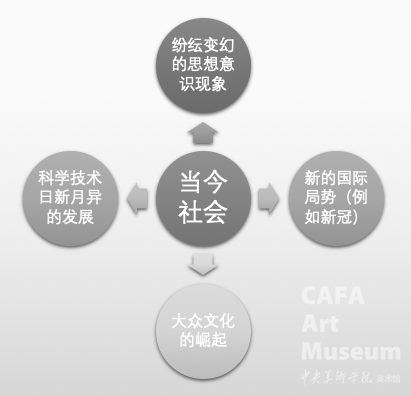
第三届“策展在中国”论坛暨2020年中国美术家协会策展委员会年会系列活动于11月3日在湖南美术馆启动。本届论坛选择了具有较强学术关注度和现实意义热点的“全球化与在地化”作为议题,以期达到拓展和深化中国策展学的研究目的。在主论坛中,中央美术学院美术馆馆长张子康受邀以《当下策展的转向与应对:艺术博物馆的智识机制建构》为题发表主旨发言。
当下策展的转向与应对:艺术博物馆的智识机制建构
张子康
中央美术学院美术馆馆长
特别荣幸能有这次交流的机会,我的发言主题是关于“智识”机构建构。想到这个课题的缘由主要是疫情之后,人们面临了很多高科技给日常生活所带来新的变化,比如,去哪里都扫码,人脸识别、信息采集、网络支付跟踪等,我们每天躺床上刷手机,靠手机推送点评、点外卖,可以说手机已经成为了一个我们的“新器官”了。在网络科技、人工智能、甚至人机对接、万物互联的日新月异的时代,新的知识形态伴随着新的技术产生。博物馆因此必须给予全方位的回应。推动博物馆发展的核心动能,已经从成立之初的典藏那个时期,到现在现代博物馆的体系,再到后现代发展为以体验为中心。博物馆对知识系统的建构在这个前所未有强调创新的时代,被更为充分地展现出来。顺便提一下,刚刚发布的十四五规划,“文化”被提到47次,“创新”被提到51次。
在这样一个新的时代,我们基于产生“智识”概念的人类认知传统和脑科学的基本研究结果,将人类的认知中“软知识”一一本质创新动能归纳为“智识”。德国有个哲学家有本书叫《有学识的无知》,显然,我所说的“智识”是相对这种“无知”和“学识"而定义的。
在美术史和博物馆学的语境中对其加以强调,目的是“超越知识的积累与传承,强调当下艺术创作的核心价值在于创新,当代博物馆发展的核心动能也在于对社会创新的推动”1。科学哲学家卡尔·波普认为人类的智识影响人类历史进程,以智识生产为基础的构建开发新智识生成一个系统,利用为学科和专业的发展进入到新的维度,也成为博物馆各项工作面对时代转向的出发点。今天的讲座我想围绕这个议题来进行。
Part 01
第一部分,何谓智识?
其实智识在西方的哲学、社会科学和自然科学等领域被使用已经有很长的历史。“由于始于18世纪的学科分类,在十九世纪后半叶至二十世纪,智识才随科学进一步发展而完善”2,因此人类对于生物智识的理解也是在糅杂多学科知识后不断的具象起来的。
不同的学科,对于智识问题都有不同程度的关注和基于本学科传统的解释。但总体来说人类的智识和人类自身的生物特征相关,同时和人类的社会特征相关。
博物馆在19世纪开始至20世纪末这段时间,真实地反映了社会、经济、政治的构成,与大学一起,代表了自然、文明和人类创造的智识的最高成就。作为智识领域的重要场所,博物馆参与了学科的分类与不同自然科学、社会科学领域的巩固,并作为毋庸置疑的来源和参考,充当了知识的传播中心和合法化者,成为人类智识的源泉之一。
智识社会的发展正在寻求对以往的范式框架的突破,当今社会纷纭变幻的思想意识现象,科学技术日新月异的发展,大众文化的崛起,新的国际形势,如新冠,形成了当下社会对范式框架的突破和思考。

梅棹忠夫说过:“人们的智识活动指向某种新颖信息的生产,进而将其引向凭借人们的思维活动进行的生产活动。在新时代的临界点,艺术界所应对的外部环境已经出现了极大的变化,也对新时代的艺术创作、艺术展示、艺术研究等艺术生产活动带来了相应的变化。”
艺术博物馆在当今的智识建构中,显示出以视听为主的感官体验为主要特征,与其他知识分支合作,传递现实的信息和迥异,为集体记忆提供支持,启发创新的思维模式等独特的社会功能。
建构智识机制来不断启发创新思维模式来梳理当代的人类认识规律与特征,正是艺术博物馆当代意义所在。我刚才讲的因为大数据时代,周围形成了大的数据,将来也会形成人类的大脑,这个大脑没有智识的思考系统。包括博物馆的数据,整个理论体系也会形成大脑,这个大脑如何在博物馆实现思考,形成智识化的体系,我认为这个对未来博物馆的发展是非常重要的。
Part 02
第二部分:智识机制建设对策展带来哪些变化?提出了哪此要求?
数字技术革命从本质上改变了时代,互联网成为全球化显著、实际的标志。数字技术革命不仅涉及到所有文化形态,使技术与文化的高度融合,同时影响了包含艺术生产与博物馆运营在内的所有非物质生产领域,改变了人类的思维与行为。虽然现在我们有很多的社会生活方式,比如说游戏,体验性很强的数字化互动项目,有意无意影响了人们的思维活动,根据科学家研究对大脑的影响,对我们基因的影响还是非常大的。
新技术带来艺术博物馆领域中首要、直接的变化,主要表现为三个方面:受众观看模式、受众参与的形态、受众思维模式。
首先,传统艺术博物馆形成的观众概念被新技术发散成为"受众”概念。即观看这一行为本身并不足以代表人们在艺术展览中所获得的全部内容。
虚拟现实、大数据、智能穿戴、增强现实等技术的发展,也同时拓展了受众对于作品可能的参与和干涉程度。受众具备可采用各种方法、通过各种途径参与到艺术作品本身中的可能性。比如说纽约大都会艺术博物馆做的项目,将游戏植入到场景中,与场景形成互动的项目,可以说这是游戏跟博物馆互动的比较典型的项目。

纽约大都会艺术博物馆为任天堂运行时间最长的游戏的1300万玩家提供了馆藏作品。在Nintento Switch游戏《动物穿越:新视野》中,通过其在线收藏中的分享按钮,纽约大都会艺术博物馆使玩家可以将馆藏作品添加到Animal Crossings:New Horizons中。
还有沉浸式展览,如:Teamlab的“花与人”。在一个小时里,可以看到花在一年四季中的绽放与凋零。作品不是将预先制作好的影像进行放映,而是通过电脑程序实时绘制而成的。整体来说,作品的图像并非复制以前的状态,而是受到观赏者行为举止的影响,持续发生变化。眼前这一瞬间的画面,错过就无法再看到了。

Teamlab “花与人”
其次,艺术生产,我们都知道艺术生产是马克思主义里面里来的,艺术家的创作,艺术作品呈现模式,艺术生态系统对新技术的应用越来越普遍。
1.艺术家的创作越来越不受材料、时间、空间等传统因素的限制,当代叙事艺术不断渗透和扩张领域。

缪晓春《无始无终》
2.新技术反映在艺术作品的各类呈现模式上。

2019年10月,巴黎卢浮宫推出了VR体验展“蒙娜丽莎:穿越玻璃”,旨在探索文艺复兴时期的绘画。这是其达芬奇大片展览的一部分。
3.艺术生态系统越来越深度倚重网络。


“古意的生成”展览是中央美术学院美术馆馆藏书画精品系列展之一。展览以自有馆藏资源为依托,在《中央美术学院美术馆藏精品大系·古代书画卷》(2018年版)的基础之上,进一步研究挖掘,将视点聚焦于明清——这一中国书画传统成熟的关键时期。
Part 03
第三部分,策展如何主动回应当下的博物馆智识机制建构
新知识形态的三个主要特征:开源、创新、交互。从这三个特征,探索艺术博物馆的策展工作如何主动根据博物馆的智识机制建构做出具体的转向和调整。
1.开源
互联网是很多程序及电脑的合成物。当我们提及诸如大数据、云技术等等词汇,在绝大多数人心目中,仍然首先是信息技术类的内容。但是新时代的信息技术又不仅仅是"技术”。互联网并不仅仅是技术的陈列展示,而具有更深的哲学社会学意义。将社会学、哲学、历史学纳入到新时代的技术认知中来,参考一些包括人类学、社会学在内的研究方法(譬如仿效人类学通过多样化素材的叠加和分析),来重新观察信息时代网络社会中的艺术和生态秩序,是艺术博物馆面对后工业时代和后网路时代叠加所需要的智识精神。
同样,我们回溯艺术场域中由"互联网”所形成的赛博空间,“技术”并不是关键词,这种技术所代表的精神一一“开源”才是。
具体到策展,在"开源”精神之下,后疫情时代策展的“源代码”3正来自于人类智识的建构。艺术策展所面临的并不是对于原策展机制格式化的重建,而是融合和拓展。其或主动、或被动的,这些新时代的特征已早早预置。
第一,回应受众的变化,策展强调与观众的融合与平等,主要表现在策展内容、结构、过程、结果的开放。
人与艺术在媒介的中介下形成一种“双重凝视”。展览呈现的作品需要观众的参与才完整,而策展人与艺术家在展览尚未成形时,创作出的作品从某种意义上是"未成形”作品。在展览展出的那一刻,作品被观众参与一一一些观众凝视,一些被凝视,这样的状态又是一个流动的过程一一作品才完整。
比如说中央美术馆美术馆举办的雷安德罗·埃利希的“太虚之境”的个展。艺术家参照“唐人街”的景观风格,设计了一幢平铺于地面的"建筑”。同时将硕大的镜面,以45度的折角悬于"建筑”上方。观众可自由地选取姿势与“建筑”互动,并借助镜面成像实现超现实的效果。其呈现的并不是我们通常认为的中国城市画面,而是西方国家的"中国城”。埃利希认为,人们会在陌生的异国他乡寻找熟悉的地方,从哲学角度这是一种人类的趋同本能。这些作品引导着观众去质疑我们对“现实”这个概念的理解的本质,同时观众亦成为作品的一部分。
雷安德罗·埃利希 《建筑》
策展人在这类展览中,和艺术家一起,往往呈现出超乎寻常的智识建构。整个展览本身的"未完成”性恰好是展览最重要的一部分,不仅仅有创作思维和理念的智识成果呈现,更是跨学科工作的执行一一从某种意义上,"未完成”的作品相较于完成的作品,需要调用更多的学科智识,也需要更多的跨学科技巧,对于空间和作品之间的关系,需要解构与重构,这其中包括现实空间和网络空间。
新时代的艺术场域不再提倡"权威”,策展人不再执着基于展出作品意义和关联背景的"二次创作”的机会。策展人也由放弃权威、放弃诠释作品这一行为,得到了更纯粹的,基于“平等凝视”的策展实践。策展从单向的传递转变为平等的交流。观众不在是旁观凝视,而成为主观艺术意涵的构造者之一。开放是的策展结构,赋予作品多重意义和多维度呈现方式。
卡普尔在央美的大展,这个艺术家的作品中不让你去解读,一开始我们写了很多的解读东西,他看了以后说我不需要去解读,因为每个观众看了之后要有自己的解读,有自己的理解,这个作品才成功。
2019年10月25日,英国艺术家安尼施·卡普尔 (Anish Kapoor) 个展正式亮相中央美术学院美术馆。作为安尼施·卡普尔在中国的首次美术馆级个展,此次展览呈现了艺术家横跨35年的重要艺术创作,展出了一系列气势恢宏、自成一体的装置作品。
第二,回应艺术生产的变化,策展人进行团队化整合。
策展人不仅仅是展览作品的决策者或者展览本身的创造者,甚至不一定是某个“人”,而是一个团队或者一个组织。策展人所做的,是一个基于展览的完整的智识工作过程,即包括艺术作品的挑选、陈列设计,也包括整合周边资源形成的诠释、传播以及商业化变现方式开发。
而展览的形式也不仅仅是作品和空间之间的关系,而是综合使用各种线上线下呈现方式。针对传统展览在实际空间的观看形成的思考和网络赛博空间的也完全不同。
就艺术策展而言,“展览物理空间与数字空间之间的交流,变成了内容与形式之间的交流。”4前线策划工作与教育、研究人员的工作也都串联起来。策展人新制度因应智识机制建构而新生。
展览的形式不仅是作品和空间之间的关系,而是综合适用各种线上线下的呈现方式,针对传统展览和网络赛博空间的也不完全相同,新生。
2.创新
在新知识形态时代,“知识的个人性与经验的独特性超越了以往对普遍性的需求”5,各领域的创新成为人类社会发展的动力。比如巴黎1989年做的大地魔术师展览,就作为临时展示纳入艺术史册,策展行为因此被重塑为知识对象,直指生产知识的本质。对此,在艺术专业领域之外,将美术馆放置在社会组织结构中,我们认为美术馆提供的不仅是艺术专业内知识的直接生产,而是生产知识的动力一一一种创新思维模式,一个智识生长的空间一一我们把这样的美术馆运营指导思想,称为智识机制的建构。
根据不同思维模式建构的渐进级别的信息显示系统可以有多种参观方式,也鼓励并促进参观者在空间中相互沟通。这种基于不同思维方式的策展与设计,使我们可以乐观向的畅想未来的展览,建构出允许超出想象的策展作品。学科在智识建构下也将不再壁垒森严。智识机制建构出新时代策展转向的艺术"自由地”。现在对展览没有那么多的边界和框框,对策展人来讲有很多新的可能性。
3.交互
交互将成为未来非常重要的艺术发展形式,不是过去的方式了,肯定是站在多视觉的创作当中。当下,当我们提到博物馆中的"交互",第一直观的反应创新媒介带给我们的“声光电”的观展体验。
事实上,"交互”在不同学科中有着相似却不同侧重的定义,社会科学、信息科学、传播学、艺术博物馆,交互是指个人或群体之间社会关系形成的相互作用。对信息科学来讲交互性是指信源之间来回传输的信息,在计算机领域中,交互性一词在20世纪90年代开始使用,它概括了多种媒体关系。从传播学来讲,交互性是基于人为中心的交流传播,(与人、机、媒介等)。在艺术博物馆,交互可以是艺术一种艺术创作理念,也是博物馆的学术工作理念,有很长的传统。
美术馆与艺术家、观众形成社会化的沟通和教育,需要不断的交互,交互的概念更多考虑的是我们站在对方的角度来思考问题,而不是站在自己主观的视觉去思考问题。
艺术作品、艺术形象与受众进行超时空对话与互动,人类智识因而作用,形成新的艺术思维和呈现模式。其实我们常见的博物馆展中的各类事件和文化体验的策划也是一种交互,这样的活动往往吸引访问者的身体、智力、情感和社交活动,创造互动性机会,提供模拟体验,影响文化参与、审美评估和意义创造。
通过促进社交活动鼓励人们与艺术空间的互动,发表意见,打破进入障碍;吸引人们对美学细节的关注,观众反应可调节对艺术品的个人评价;艺术专业人士和非专业意见交流融合平台。
通过数字信息技术来审视艺术创作的变化,并在策展话语中反应出来,提示文化和知识创新的方向,正是智识生成的过程,而非单纯的技术应用和知识传递。
同时,结合传统的观众与作品互动方式,现代策展考虑到展览与受众关系在数字时代的新变化(对受众认知的放大),不设限的形成各种可能性,建构多角度互动合作式的智识生产机制。
现在很多新的作品体验性很强,在体验当中给观众带来了认知,并在认知当中产生主动思考的能力。从艺术家的作品到整个策展过程中一定要考虑到是否能够通过展览真正给社会带来创造性的推动,培养人们创造性的思维,我认为这点非常重要。
与此同时,美术馆的智识建构对未来教育也起到非常大的作用,这几年博物馆陆续在教育概念里提出学习概念,并探讨博物馆如何建造一种新的学习系统。在大学中,往往缺少创新的课程,博物馆在这个时期建立这样一个“智识”系统,可以让每个人都能够通过博物馆的“大脑系统”去思考,然后使其生成新的知识,推动创造力!
注释
【1】张子康、罗怡《艺术博物馆》,北京:文化艺术出版社 2017,P5。我们提出:“博物馆的定义更新可以突出博物馆,尤其是艺术博物馆的文化的主动推动力和文化的自身创造力。”
【2】现代百科全书的奠基人,《百科全书,或科学、艺术和工艺详解词典》的主编德尼・狄德罗与他的副编让·勒朗·达朗贝尔在他们的百科全书中,为人类纂写了一个总结了当时整个知识系统的知识地图,标题译成英文为『Map of the System of Human Knowledge』,学术界称之为狄德罗和达朗贝尔之树(the tree of Diderot and d'Alembert)或具象人类知识系统(Figurative system of human knowledge)。“知识树”将知识分为与人类理解相关的三大部分:记忆(包括历史和自然的历史),理性(哲学,数学和法律),想象力(艺术)。
【3】源代码同代码一样是一组由字符、符号或信号码元以离散形式表示信息的明确的规则体系。是相对目标代码和可执行代码而言的。目标代码是指源代码经过编译程序产生的能被cpu直接识别二进制代码。可执行代码就是将目标代码连接后形成的可执行文件,当然也是二进制的。计算机源代码的最终目的是将人类可读的文本翻译成为计算机可以执行的二进制指令,这种过程叫做编译,通过编译器完成。笔者用“源代码”来比喻“智识”和艺术策展之间的关系就像源代码和程序之间的关系。
【4】《后互联网时代的策展》鲍里斯·格罗伊斯著,李鑫译,英文原文来自 e-flux 杂志第94期。
【5】《网络技术重构人文知识》王炎,《读书》杂志2020第1期。
